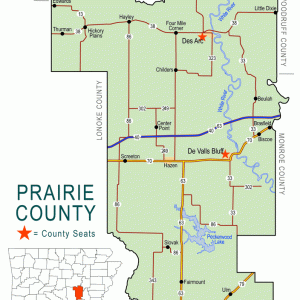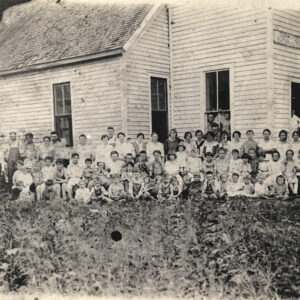calsfoundation@cals.org
Biscoe (Prairie County)
aka: Fredonia (Prairie County)
| Latitude and Longitude: | 34°49’15″N 091°24’15″W |
| Elevation: | 187 feet |
| Area: | 0.96 square miles (2020 Census) |
| Population: | 305 (2020 Census) |
| Incorporation Date: | July 27, 1909 |
Historical Population as per the U.S. Census:
| 1810 | 1820 | 1830 | 1840 | 1850 | 1860 | 1870 | 1880 | 1890 | 1900 |
| – | – | – | – | – | – | – | – | – | – |
| 1910 | 1920 | 1930 | 1940 | 1950 | 1960 | 1970 | 1980 | 1990 | 2000 |
| – | 310 | 402 | 395 | 406 | 350 | 340 | 486 | 484 | 476 |
| 2010 | 2020 | ||||||||
| 363 | 305 |
Biscoe, also known as Fredonia, is located on Surrounded Hill between the White River and the Cache River in eastern Prairie County. It is on U.S. Highway 70 a few miles east of DeValls Bluff (Prairie County).
Surrounded Hill was surveyed by the federal government in 1849. Edwin Burr was the first settler to claim title to the land, registering his deed in Batesville (Independence County) in 1853. The area remained relatively unpopulated through the Civil War but gained significance with construction of the Memphis and Little Rock Railroad, which was completed through the Surrounded Hill area in 1871. A depot was built on flat land near the hill, and a post office was established in 1872 with the name Fredonia. The name of the post office was changed to Surrounded Hill in 1875, renamed Fredonia in 1881, then renamed Surrounded Hill again later the same year, and finally named Biscoe in 1902. The name Biscoe appears to have been chosen to honor landowner John Biscoe. An African American Baptist church was established in 1872. Eldridge Atkins acquired land in the area in 1874, and Abraham Boyd acquired land a few years later, which he divided into lots and sold to prospective homeowners. Boyd referred to the developing community as Fredonia.
By 1886, the community had a population of 250, including two merchants and one physician. The community also had two cotton gins and three churches: Baptist, African Methodist Episcopal, and Colored Methodist Episcopal (later Christian Methodist Episcopal). It also had two schools—one for white children and one for African-American children. By 1890, the community had two general stores, two grocery stores, two saloons, a post office, a hotel, a blacksmith shop, a steam-powered cotton gin and grist mill, and two African-American churches.
The community was incorporated in 1909, apparently using the name Biscoe, though residents continued to call the town Fredonia. A two-story brick building was constructed for use as the school for black children in 1920. During the early decades of the twentieth century, Biscoe had a successful local baseball team. Led by pitcher Bill Thomas, the team regularly defeated teams from Brinkley (Monroe County), Cotton Plant (Woodruff County), Hazen (Prairie County), and other surrounding towns. Jennie Carr Pittman, born in Biscoe in 1858, fought for temperance well into the 1920s and 1930s. In the first half of the twentieth century, the town acquired a stave mill and a service station. During the Flood of 1927, the Red Cross cared for nearly 2,000 refugees at Biscoe. By 1937, Biscoe had a community hall, two schools, five churches—all African-American—eight general stores, a drugstore, a barber shop, two bus stations, two blacksmith shops, two gins, three filling stations, a train depot, and a post office. A Baptist church for whites was built in 1951. About the same time, a Church of Christ was established.
During the 1960s, the schools of Biscoe were consolidated into the DeValls Bluff School District, desegregating in the same action. The Cache River National Wildlife Refuge was established along the Cache River east of Biscoe. With its headquarters in Augusta (Woodruff County), the refuge encompasses more than 60,000 acres of wetlands and hardwood forests, protecting habitats and providing feeding and resting area for migrating waterfowl.
The population of Biscoe in 2020 was 305. The city has several agricultural businesses, including Chesser Enterprises, as well as a grocery store, a post office, and two churches.
For additional information:
Sayger, Bill. Biscoe Remembered. N.p., 1989.
Steven Teske
Butler Center for Arkansas Studies
 Cache River
Cache River  Prairie County Map
Prairie County Map  Surrounded Hill School
Surrounded Hill School 




I was born on the Little Farm in 1950. My parents were sharecroppers picking cotton.
I’ve lived in Biscoe my entire life and have never heard anyone refer to it as Fredonia.